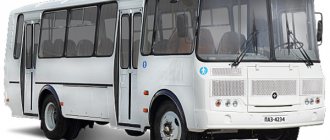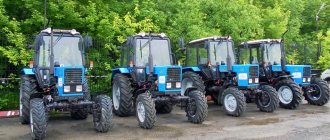Minibuses have long been firmly established in our lives. They transport enterprise employees, children from small villages to settlements where there are schools, and, of course, work on regular city, suburban and intercity routes. But large factories that produce basic chassis (for example, GAZ) are not flexible, they are not able to adapt to all the needs of a particular client - mass production technology does not allow this. Then relatively small enterprises come into play - such as the Nizhny Novgorod company PKF Luidor. Luidor 225000 buses continue to gain popularity among carriers. There are more and more of these machines, and the geography of their operation is incredibly wide - this is, in fact, the entire territory of Russia.
: how vans are converted into minibuses and ambulances
Minibuses have long been firmly established in our lives. They transport enterprise employees, children from small villages to settlements where there are schools, and, of course, work on regular city, suburban and intercity routes. But large factories that produce basic chassis (for example, GAZ) are not flexible, they are not able to adapt to all the needs of a particular client - mass production technology does not allow this. Then relatively small enterprises come into play - such as the Nizhny Novgorod company PKF Luidor. Luidor 225000 buses continue to gain popularity among carriers. There are more and more of these machines, and the geography of their operation is incredibly wide - this is, in fact, the entire territory of Russia.
As you know, the GAZ plant already has its own minibus in its range, built on the chassis of the well-deserved Gazelle Next. It has an index of 3221. But over the years of production, people operating these machines have had two serious complaints:
- the sliding door is suitable for a van or ambulance.” But it is inconvenient in city conditions, as it often breaks down. But opening and closing it is very difficult for passengers. Especially in a crowded cabin.
- The ceiling is too low, which creates inconvenience for those moving to their place. Even a person of average height has to bend down a lot to avoid hitting his head on the ceiling.
Luidor has been building 225,000 for years - a bus, photos of whose characteristics are found in abundance on the Internet.
GAZ Gazelle Luidorka on DRIVE2.RU
Hello! Car GAZ 322133 LUIDOR-225000 (14 seats) UMZ-4216 engine (gasoline) Good minibus Gazelle Business Luidor with a high roof (which gives a great look), comfortable doors for passengers (hinged), UMZ engine (no questions yet), power steering (makes driving easier, provided you keep an eye on the king pins (I syringe once a week)), heated mirrors!
The mileage for 3000 km is normal! At 2000 km I passed the first warranty maintenance (pulling all the bolted connections, tightening the cylinder head, changing the oil in the engines (PETRO-CANADA), and so on little things = the price of the issue is expensive and I would have done all the work myself, I won’t go for the next maintenance. The car has been delivered on the route (passenger transportation). While I'm riding myself, I plan to hire drivers (worthy ones). In principle, the bus is not bad, further operation will show. Good luck on the roads!
- Engine 2.8 petrol (106 hp)
- Manual Transmission
- Rear drive
- The car was purchased in 2014
- GAZ Gazelle has been produced since 1994
Five years on the site Description changed 2 years ago
Fuel consumption Gazelle Farmer. Specifications
The stable growth of this segment is due to the emergence of private companies providing services for the delivery of bedridden patients to the hospital during planned hospitalization or from the hospital to home. Eliminate the possibility of using fastening points for dismantled seats by installing permanent plugs that cannot be removed using conventional plumbing tools. Consolidated resolution on the design of CP vehicles.
| Wheels | Disc, with non-separable rim 5½ Jx16h3 |
| Tires | Pneumatic, radial, tubeless, size 185/75R16C |
| Suspension: front rear | Independent, wishbone with coil springs, with anti-roll bar Two longitudinal, semi-elliptical springs with additional springs, with or without anti-roll bar |
| Shock absorbers | Four - gas-filled, telescopic, double-acting |
Technical characteristics of GAZelle NEXT
Parameters
standard/extended base
standard/long base
new model 4.6 t С45R92-80
new model 4.6 t С46R92-80
| Number of seats Passenger capacity | 2+1 2 | 5+1 5 | 2+1 2 | 5+1 5 |
| Wheel formula | 4×2 | 4×2 | 4×2 | 4×2 |
| type of drive | rear | rear | rear | rear |
| Total weight, kg | 3500 | 3500 | 4600 | 4600 |
| Weight of the equipped vehicle, kg*** | 2280/2400 | 2395/2520 | 2542 | 2656 |
| Load distribution of the vehicle's total weight on the road through tires, kg*** front wheels rear wheels | 1280/1465 2220/2035 | 2150/1960 3145/3745 | 1650 3300 | 1650 3300 |
| Base, mm | 3145/3745 | 3145/3745 | 3745 | 3745 |
| Front wheel track, mm | 1750 | 1750 | 1750 | 1750 |
| Rear wheel track (between the centers of dual tires), mm | 1560 | 1560 | 1560 | 1560 |
| Ground clearance (under the rear axle housing at full weight), mm | 170 | 170 | 170 | 170 |
| Minimum turning radius along the track of the outer front wheel, m | 5,7/6,5 | 5,7/6,5 | 6,5 | 6,5 |
| Maximum vehicle speed on a horizontal section of a flat highway, km/h | 130 | 130 | 130 | 130 |
| Overhang angle (with load) front, degrees. rear, deg. | 22 14/13 | 22 14/13 | 22 12 | 22 12 |
| Maximum gradeability with main fuel at full load, % | 26 | 26 | 26 | 26 |
| Internal overall dimensions of the body, mm length width height | 3031/3631 1860 1927 | 2400/3000 1860 1927 | 36311860 1927 | 30001860 1927 |
| Cargo compartment volume, cubic meters | 11,5/13,5 | 7,5/9,5 | 13,5 | 9,5 |
| Gear box | 5 manual transmission | 5 manual transmission | 5 manual transmission | 5 manual transmission |
| Fuel tank capacity, l | 79 | 79 | 79 | 79 |
Parameters
(vehicle with 3-seater cab, standard and short wheelbase)
(vehicle with 7-seater cabin)
Option package “Comfort 1” Option package “Comfort 2” (3-seat cabin) Same as “Comfort 1” with the following options: Option package “Comfort 2” C2-2 (7-seat cabin) Same as “Comfort 2” with the following options : Other options
| Sprung driver's seat "standard" (with separate height and horizontal adjustment of the cushion, adjustable backrest angle) | ||
| Cigarette lighter, ashtray | ||
| 12V socket | ||
| Additional 12V socket (in the rear) | ||
| Interior light (rear) | ||
| Cabin filter | ||
| Radiator insulation | ||
| Ceiling console | ||
| Heating and ventilation system | ||
| Ventilation hatch (material: glass with silk-screen printing) | ||
| Weight of the equipped vehicle, kg | 2220* (2205**)/2155* (2130**) | 2340* (2325**)/2190* (2165**) |
| Full size spare tire | ||
| Tool kit | ||
| Brake pad wear indicator | ||
| Headlight unit with daytime running lights with tilt angle corrector | ||
| Preparation for connecting a tachograph (place + wire) | ||
| 1DIN head unit: CD-MP3 receiver with AM/FM tuner with control buttons on the steering wheel and USB | ||
| Fog lights | ||
| Driver's seat "luxury" (sprung, with armrest, adjustments, lumbar support, heating) | ||
| Preheater-heater | ||
| Additional heater | ||
| Platform with rolled sides, plywood flooring, awning | ||
| Platform with aluminum sides, plywood deck | ||
| Fire extinguisher | ||
| Tachograph | ||
| Set of door pockets (1 left + 1 right)*** | ||
| Rear door pocket*** |
Parameters Values
| Wheels | Disc, with non-separable rim 5½ Jx16h3 |
| Tires | Pneumatic, radial, tubeless, size 185/75R16C |
| Suspension: front rear | Independent, wishbone with coil springs, with anti-roll bar Two longitudinal, semi-elliptical springs with additional springs, with or without anti-roll bar |
| Shock absorbers | Four - gas-filled, telescopic, double-acting |
Parameters ISF2.8s4R148 Evotech A274 Evotech A275 with LPG (Propane)
| Engine's type | Diesel, with turbocharging and charge air cooler | Gasoline, 4-stroke, injection | Bi-fuel, 4-stroke, injection (gasoline/gas) |
| Number of cylinders and their location | 4, in-line | 4, in-line | 4, in-line |
| Cylinder diameter and piston stroke, mm | 94×100 | 96,5×92 | 96,5×92 |
| Cylinder displacement, l | 2,8 | 2,69 | 2,69 |
| Compression ratio | 16,5 | 10 | 10 |
| Rated power, net kW (hp) at crankshaft speed, rpm | 110 (149,6) 3400 | 78,5 (106,8) 4000 | 78.5 (106.8) on gasoline 76.7 (104.3) on gas 4000 |
| Maximum torque, net, N*m (kgcm) at crankshaft speed, rpm | 330 (33,6) 1800-2600 | 220,5 (22,5) 2200-2500 | 220.5 (22.5) on gasoline; 219 (22.3) on gas 2200-2500 |
| Crankshaft rotation speed in idle mode, rpm: minimum increased | 750±50 4500 | 800±50 3000 | 800±50 3000 |
| Direction of rotation of the crankshaft (observed from the fan side) | Right | Right | Right |
| Cruising range from one refueling when driving on all types of fuel | — | — | 870 |
| ECU | — | — | single |
| Total capacity of the gas cylinder system, cubic m/kg | — | — | 70 |
| Control fuel consumption when driving at a constant speed: 60 km/h, l/100 km 80 km/h, l/100 km | 8,5 10,3 | 9,8 12,1 | — — |
| Control gas consumption when driving at a constant speed: 60 km/h, l/100 km 80 km/h, l/100 km | — — | — — | 11,8 14,5 |
Clutch Single disc, dry, hydraulically driven
| Gearbox (for diesel vehicle) | Mechanical, 5-speed Gear ratios: 1st gear - 3.786 2nd gear - 2.188 3rd gear - 1.304 4th gear - 1.0 5th gear - 0.794 Reverse - 3.28 |
| Gearbox (for a car with a gasoline engine) | Mechanical, 5-speed Gear ratios: 1st gear - 4.05 2nd gear - 2.34 3rd gear - 1.395 4th gear - 1.0 5th gear - 0.849 Reverse - 3.51 |
| Cardan transmission | Two shafts with three universal joints and an intermediate support |
| Rear axle final drive differential | Hypoid, gear ratio - 4.3 Bevel, gear |
Description. Description of work
| Change of category LUIDOR 225000 III —- ————- ————- ———— ————— ————— ————— ————— —————— ——— ——— ————— ————— ————— ————- 56 Ulyanovskaya 5. Initial data - the basic fuel consumption per mileage for an onboard KamAZ-5320 vehicle is Hs 25.0 l 100 km ; — the fuel consumption rate for transporting payload is Hw 1.3 l 100 t km; — the fuel consumption rate for the additional weight of a trailer or semi-trailer is Hg 1.3 l 100 t km; — the bonus for work in winter is D 8, for work in mountain conditions at an altitude of 800 to 2000 m above sea level D 10; — weight of the equipped trailer GKB-8350 Gpr 3.5 tons; — the fuel consumption rate for the mileage of a road train consisting of a KamAZ-5320 vehicle with a GKB-8350 trailer is Hsan Hs Hg x Gpr 25 1.3 x 3.5 29.55 l 100 km. |
| Gazelle fuel consumption and its material consumption standards In 2020, the rules established in the field of use of fuels and lubricants continue to apply in accordance with the order of the Ministry of Transport dated 14. On the other hand, this direction has almost completely selected all its reserves both in terms of the quality of the products offered to operators , and in terms of comfort for passengers. |
- Engine 2.8 petrol (106 hp)
- Manual Transmission
- Rear drive
- The car was purchased in 2014
- GAZ Gazelle has been produced since 1994
Specifications
Buses have the following characteristics:
- external dimensions of the machine – 570x238x286 cm;
- internal dimensions of the passenger compartment: 310x183x188.5 cm. At the same time, the height is 38.5 cm more than that of a standard Gazelle;
- number of seats - 14 for passengers and 1 for the driver. Transporting people while standing is not allowed by the manufacturer;
- A UMZ 4216 gasoline injection engine is installed under the hood. With a displacement of 2.9 liters, it produces a maximum power of 107 hp. at 4000 rpm;
- fuel consumption – 10.5 liters per “hundred” at 60 km/h, 13 liters per 100 km – at a speed of 80 km/h.
Be sure to read: Ford Transit onboard: technical specifications
In general, the technical characteristics of the Luidor 225000 do not differ very significantly from the base Gazelle, because the changes affected mainly the interior.
How are regulations regulated?
A vehicle requires fuel to operate. Each category of car requires different volumes of fuel and lubricants. The Ministry of Transport has developed a special standard - this is the fuel consumption rate for car brands. The standard allows you to determine how much fuel and lubricants a specific brand of vehicle requires to support the technological process. The standards are developed only in relation to the operating process of vehicles. For example, it is unacceptable to use values to calculate the write-off of fuel and lubricants during repair, adjustment or testing. For technological purposes, additional fuel consumption standards (FLC) should be established.
The Ministry of Transport introduced the standards by a separate Order No. AM-23-r dated March 14, 2008 (as amended on September 20, 2018). The document establishes several categories of standards for fuel and fuel consumption:
- Basic standard for gasoline consumption in liters per 100 km in running order.
- Transport standard in liters per 100 km in operation (during transport work), including:
- cost standard for a bus taking into account curb weight and nominal passenger load;
- consumption standard for dump trucks, taking into account equipment and nominal vehicle load.
- Transport standard for a truck in liters per 100 ton-kilometers, determined during transport work.
Standards are set in liters, for example, for gasoline or diesel fuel. Or the standards are fixed in cubic meters if, for example, transport consumes gas.
Formula for calculating fuel consumption for a bus • Technical parameters
| Fuel consumption standards The use of heaters is assumed in the winter when cars operate according to fuel consumption standards using winter allowances, as well as in the cold season when the average daily temperature is below 5 degrees. III —- ————- ————- ———— ————— ————— ————— ————— —————— —————— ———— ————— ————— ————- 49 Kirovskaya 4. |
GAZ 13 seats all-wheel drive passenger minibus • The most recent amendments were made by Order 06.
Summer fuel consumption standards in 2020
For the summer period, norms are calculated according to established coefficients, without adjustment. The changes affected cities with a population of over a million, in which there is a link to the population.
For cities with a population of 1 to 5 million, the consumption rate was increased by 25%. In cities with a population of more than 5 million people, the standard was increased by 35%. This is largely due to increased road congestion and growing traffic jams. Standing idle in such traffic jams leads to increased fuel consumption.
Transport owners also need to take into account changes in the procedure for applying the increase factor depending on the mileage accumulated by the bus. The 5% increase applies to vehicles that have already covered 100 thousand kilometers traveled or whose age is more than 5 years. The value increased by 10% with a mileage of more than 150 thousand kilometers or an age of 8 years or more.
Minibus equipment
031 YaMZ-236M2-6V-11.15-180-5M 41.5 D MARZ-5266 YaMZ-236 HE-6V-11.15-230-5M 38.3 D MARZ-52661 YaMZ-236 HE-6V-11 ,15-230-5M 41.2 D Stayer Mercedes-Benz 0303AKA-15KHP A OM 442-8V-15,078-296-6M 25.4 D Leader Mercedes-Benz 0303AKA-15RHS OM 442-8V-15,078-296-6M 30 ,2 D Vityaz Mercedes-Benz 0303AKA-15RHD OM 442A-8V-14.6-365-6M 28.3 D PAZ-672, -672A, -672G, -672M, -672S, -672U, -672Yu 34.0 B PAZ-3201, -3201S, -320101 36.0 B PAZ-3205, -32051 with engine. 11-8V-10.85-240-10M 24.5 D KamAZ-53217 21.5 D LNG or 6.5 26D KamAZ-53218 23 LNG D 6.5 or 26D KamAZ-53219 22 LNG D 6.5 or 26D KrAZ-255B, -255B1 42.0 D KrAZ-257, -257B1, -257BS, -257S 38.0 D KrAZ-260, -260B1, -260M 42.5 D MAZ-514 25.0 D MAZ-516, 516B 26.0 D MAZ-5334, -5335, -533501 23.0 D MAZ-53352 24.0 D MAZ-53362 YaMZ-238-8V-14.86-300-8M 24.3 D MAZ-53366 YaMZ- 238M2-8V-14.86-240-5M 25.5 D MAZ-5337, -53371 23.0 D MAZ-543 98.0 D MAZ-6303 8V-14, 86-300-8M 26.0 D MAZ- 7310, -7313 98.0 D UAZ-451, -451D, -451DM, -451M 14.0 B UAZ-452, -452D, -452DM 16.0 B UAZ-3303 4L-2.
Commercial vehicles GAZ
The Luidor 225000 model differs from other versions of minibuses in that it does not have an external step in its structure, which does not increase the overall dimensions of the vehicle and allows you to drive close to stops. The function of such a step is played by the lowered threshold of the swing door. All parts in the minibus interior are made of durable plastic. The interior trim (ceiling, side elements, trim on the doors and under the windows) is made of aluminum panels, which are covered with a special fabric.
Minibus equipment
Finishing gazelle Luidor 225000
The manufacturer paid a lot of attention to the comfort of this vehicle. The Luidor 225000 minibus has machine components made of durable plastic. When finishing the interior, aluminum panels covered with a special fabric were used. The anatomical seats installed in the vehicle cabin allow you to take care not only of comfort, but also of the spinal health of the people being transported.
The car moves smoothly, and even long trips will not be exhausting. This became possible due to the body of the minibus, equipped with thermal insulation and sound insulation. The vehicle floor covering is made of a special material that has water-resistant, non-slip and antistatic properties. This helps prevent passengers from being injured when the minibus moves or suddenly stops.
Use of Luidor bus 225000
The bus for transporting passengers is quite popular throughout the Russian Federation. The attractiveness of this transport lies in its low cost, and it is very convenient for route transportation of passengers.
Often, when boarding, you have to jump into a minibus from the sidewalk; this manipulation is especially difficult for older people. The Luidor 225000 minibus does not have an external step - this is the main distinguishing feature of this vehicle. This design development allows the car to park close to the curb at bus stops.
Bus Luidor-225000
The bus can be used not only as a passenger taxi, but also for other purposes:
- The presence of comfortable passenger seats will allow the Luidor to be used for intercity transportation or for travel on suburban routes.
- The presence of an air conditioning system will provide additional convenience for passengers.
- The minibus can also be used for excursion or tourist trips around the city.
- A wide panoramic view, soft and wide seats with comfortable backs and armrests will allow you to enjoy the beauty of city landscapes or nature in comfortable conditions.
Vehicle description Technical parameters
| How to calculate fuel consumption standards for a bus by order of the Ministry of Transport I would especially note that the new building is opening not in the capital of the region, but in the regional center in Balakhna, stressed the Plenipotentiary Representative of the President of Russia in the Volga Federal District Igor Komarov. But large manufacturing plants of basic chassis, for example, GAZ, are not flexible, they are not able to adapt to all the needs of a particular client; mass production technology does not allow this. |
- Gazelle Luidor 225000 has 15 seats (14 for passengers and 1 for the driver);
- When creating the minibus, manufacturers provided a high roof, which gives the vehicle an excellent appearance;
- swing doors that are comfortable for passengers;
- there is a ventilation hatch;
- The minibus has panoramic glazing and also has 2 windows;
- There is a handrail at the entrance to the car; there is an upper reinforced long handrail.
Technical specifications
Gazelle Luidor 225000 has the following technical characteristics:
Dimensions Luidor-225000
- dimensions of this model – 570x238x286 cm;
- The interior parameters are impressive - 310x183x188.5 cm;
- the weight of the bus reaches 3.5 tons;
- gasoline engine volume – 2890 cm³;
- the vehicle is equipped with a manual transmission;
- rear stabilizer available;
- there is a heating system;
- the ASR safety system, successfully thought out by the plant's designers, which works as an anti-lock braking system when braking and as an anti-slip system when moving the car;
- the driver's cabin is 30 cm away from the passenger compartment;
- a corrugated aluminum partition separates the driver's seat from the cabin itself.










